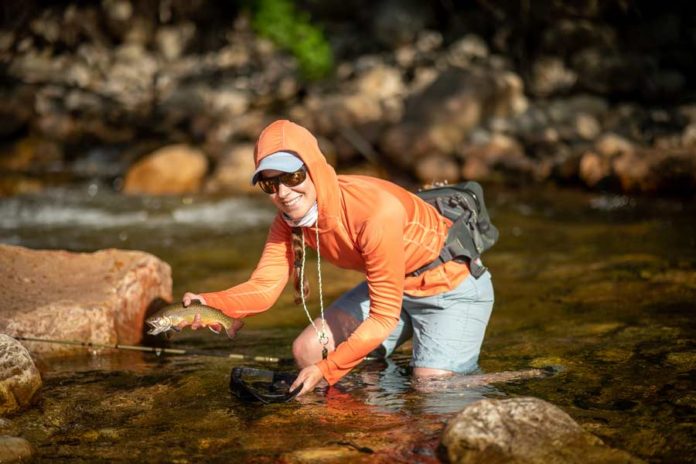All photos by Drew Nisbet, except where noted
One of the great joys of summertime fishing is the opportunity to leave the waders at home and actually feel the river or the lake against your legs in a more intimate way. No waders also means easier hiking, more mobility, and more overall comfort on the water.
In olden times–say, the 1990s–wet wading meant throwing on any old shorts and a pair of Tevas or Chuck Taylors. But we’ve come a long way, baby, and there is now a wide variety of fly-fishing gear designed for the wet-wading, warm-weather time on the water. Here’s a toe-to-head run-down that will help you dress for success on the water this summer.
Footwear

What you wear on your feet is probably the most important choice you’ll make. There are three main problems with simply wearing sandals or sneakers for fishing: traction, toe protection, and debris. The streams here in southwestern Vermont are freestones, with rocks that range from the size of a grape to the size of a Volkswagen. As the summer progresses, a thin film of algae grows on the rocks, which can make them incredibly slippery and dangerous. A fall in one of these boulder gardens is a threat to both body and fly rod. I say this from experience, having broken my irreplaceable Trident T3 4-weight in such a fall a couple years ago. As I went down, I put out my rod hand to break my fall and felt the blank break beneath the handle as I landed.
You’ve also got to watch your toes. The last time I wore Tevas in a mountain stream, my foot slipped on a rock, jamming my exposed toes under a boulder. I lost most of the skin off the tops of my toes, cracked a couple of nails, and spent the next hour dressing the wounds and limping back to the car.

Finally, open sandals and sneakers allow sand, small rocks, and other debris to get under your feet, which is super uncomfortable. Depending on the substrate of the stream you’re fishing, you could spend a lot of time trying to get that junk out of your shoes.
There are two ways to solve these problems: wear a shoe specifically designed for wet-wading or an actual wading boot. The new PRO Approach Shoes are the end result of three years of testing in the field, and they feature the best technology available in wet-wading shoes. The Michelin Outdoor Extreme rubber outsoles are sticky and solid enough to keep you upright, a rubber bumper system protects the toes, and the integrated Ariaprene® sock prevents debris from entering the shoe while providing excellent ankle support and breathability. To learn more about the Approach Shoes, watch this excellent interview with their designer, Jim Kershaw.

I would love to wear these new shoes, but an old soccer injury has left me with a dumb, arthritic, bulbous big toe that requires me to wear a much stiffer shoe. I wear a pair of Ultralight Wading Boots paired with neoprene socks. This setup affords me the stability I need, solves the three problems listed above, and allows me to add metal studs to the soles for even better traction. The neoprene sock makes the boots fit more snugly and does keep my feet warm when I’m wading in very cold water, such as below a bottom-release dam. I don’t look as cool as my colleagues sporting the Approach Shoes, but I can scamper around on slippery rocks with ease.
Shorts and Pants

I enjoy wearing shorts as much as possible when I wet-wade because I love the feel of the water against my skin, and it’s easier to go for a post-fishing dip on really hot days. Pants become a better option when the bugs are really bad or when you don’t want to slather up with sunscreen. Either way, you want the shorts or pants to be made of lightweight, quick-drying material. Even in midsummer–especially in the Rockies–the weather can change quickly. You don’t want to be wearing wet pants when the temperature plummets and a hailstorm kicks up. That’s a recipe for hypothermia, and it’s simply uncomfortable.

Jackson Stretch Quick-Dry Shorts and Pants are made from a moisture-wicking, nylon stretch fabric with a UPF 50 rating, and both are perfect for the kind of rock-hopping we do on the streams flowing out of the Green Mountains.
Shirts and Hoodies

When I was a guide in Alaska and Montana back in the 1990s, I wore tee-shirts or lodge polos all summer–and I’ve got the dermatologist bills to show for it. These days, I am all about covering up, and modern technology has provided us with fabrics that are super light, breathable, and even sun-protective. The PRO Sun Hoodie (men’s/women’s) offer the maximum coverage and the most features. The fabric spreads moisture quickly over a large area to provide rapid evaporation and enhanced cooling, it’s rated UPF 50 for maximum sun protection, and it even offers odor control. Drirelease is another great fabric for wet wading, and it comes in even more colors and prints. If you’re not a hoodie kind of person, there are also crew-neck versions.
For anglers who prefer collared shirts, the PRO Stretch Long-Sleeved Shirts (men’s/women’s) feature UPF 30 sun protection and are a great combination of classic style and high-tech. The fact that they come in attractive plaids means they don’t scream “Look, I’m a fisherman!” to everyone who sees you. (But maybe you want to make that kind of impact.) Either way, add a Buff to protect your neck and face, and you’re ready to roll.
In Part II, we will cover rods, lines, and flies.
Click here to see the Orvis Wet-Wading Collection
Credit: Source link






























